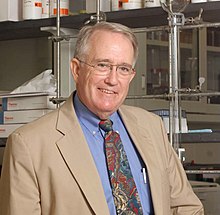Amos Smith
Amos Brittain Smith III. (Born August 26, 1944 in Lewisburg, Pennsylvania) is an American chemist ( organic chemistry , bioorganic chemistry, total synthesis) and professor at the University of Pennsylvania .
Life
Smith studied chemistry from 1962 at Bucknell University with a combined bachelor's and master's degree (1966) and received his doctorate in 1972 from Rockefeller University in biology (life science). In 1973 he became an assistant professor and later professor at the University of Pennsylvania, where he was also a member of the Monell Chemical Senses Center. He was Associate Director of the Penn Center for Molecular Discovery (PCMD) and from 1976 to 2000 a member of the Laboratory for Research on the Structure of Matter (LRSM). Smith is a Rhodes-Thompson Professor of Chemistry and served on the Faculty of Chemistry from 1988 to 1996.
In 1980 he was visiting professor at Columbia University , 1982 at Cambridge University and he was visiting professor in Auckland, New Zealand.
plant
He deals with the development of novel synthetic methods in organic chemistry (as well as synthetic methodology and reaction mechanisms) and their application to the total synthesis of natural and artificial organic molecules with complex architecture and biological functions. Among other things, he developed peptide mimetics using non-peptides, including a renin inhibitor and HIV protease inhibitors with Ralph Hirschmann (based on pyrrolines that bind to a β-sheet ) and drugs (diagnostics) in connection with neurodegenerative diseases ( tauopathies such as morbus Alzheimer's disease ). He is also involved in protein folding, the search for drugs that prevent HIV from entering the cell, and the synthesis of novel columnar liquid crystals and fullerene derivatives. With Stephen Benkovic he developed haptens for catalytic antibodies that can bind to peptides. With Peter C. Jurs , he investigated the chemical communication of brown-backed tamarins using computer pattern recognition processes and ultra-fast photofragmentation reactions (based on tetrazene ) that cause conformational changes of peptides on time scales under a nanosecond.
In organic synthesis methods, for example, he developed processes to unite the components of complex molecules (Anion Relay Chemistry, ARC, Petasis-Ferrier rearrangement ).
Honors, memberships, editing
In 2014 he received the William H. Nichols Medal and in 2015 the Perkin Prize for Organic Chemistry . He is a Fellow of the American Academy of Arts and Sciences and the American Association for the Advancement of Science . From 1978 to 1983 he received the Camille and Henry Dreyfuss Teacher-Scholar Award. In 1991 he received the Arthur C. Cope Scholar Award, in 1992 the Humboldt Research Prize , in 1993 the Ernest Guenther Award and in 2002 the Centenary Prize of the Royal Society of Chemistry . In 1990 he received the medal from the Kitasato Institute of Microbial Chemistry in Tokyo, where he was also visiting director. He is a member of the Japanese Chemical Society and an Honorary Member of the Japanese Pharmacological Society. In 1978 he received an honorary degree (MA) from the University of Pennsylvania. In 2004 he was awarded the Japanese Order of the Rising Sun . He is an honorary doctorate from Queen's University Belfast and was a Guggenheim Fellow in 1985 .
In 1998 he was the first editor of Organic Letters and served on the editorial boards of the Journal of the American Chemical Society, Organic Synthesis, Accounts of Chemical Research, Journal of Organic Chemistry, Journal of the Chemical Society, Tetrahedron Publications, Synlett, the Perkin Transactions, des Journal of Antibiotics, Fullerene Science and Technology, Organic Reactions, and other journals.
Web links
Individual evidence
- ↑ Birth and career data according to American Men and Women of Science , Thomson Gale 2004
| personal data | |
|---|---|
| SURNAME | Smith, Amos |
| ALTERNATIVE NAMES | Smith, Amos Brittain (full name) |
| BRIEF DESCRIPTION | American chemist |
| DATE OF BIRTH | August 26, 1944 |
| PLACE OF BIRTH | Lewisburg, Pennsylvania |
